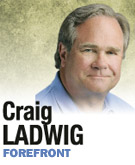Subscriber Benefit
As a subscriber you can listen to articles at work, in the car, or while you work out. Subscribe Now
 When the tide defied Canute, the great king of the Danes, he leapt back from the advancing water to proclaim: “Let all men know how empty and worthless is the power of kings, for there is none worthy of the name, but He whom heaven, earth, and sea obey by eternal laws.”
When the tide defied Canute, the great king of the Danes, he leapt back from the advancing water to proclaim: “Let all men know how empty and worthless is the power of kings, for there is none worthy of the name, but He whom heaven, earth, and sea obey by eternal laws.”
After which, he hung his golden crown on a crucifix, never to wear it again.
So Canute, it turns out, exemplified not hubris but humility. If you want an honest-to-goodness, unrepentant example of official hubris, turn to Indiana’s suspension of the fourth dimension of the physical universe—the time of day.
Yes, it’s back: the time change. A University of Notre Dame professor is saying we didn’t fix the time problem five years ago. We made it worse.
The Canute-like challenge was first issued by a younger and less-wise Mitch Daniels. A Washington reporter asked Daniels what he planned to do if he were elected Indiana governor. At the very least (wink, wink), he thought he could get Hoosiers on the same time.
That got the expected chuckles from the sophisticates in the Eastern seaboard press corps. They had been taught the Hoosier stereotype at the knees of their journalism professors; the rubes don’t even know the time of day.
Daniels, though, having to actually deal with those rubes as a candidate and then as their governor, might wish he had thought this thing through a bit more carefully. He would have benefited from the counsel of John Gaski, an associate professor of marketing at Notre Dame.
In a new white paper, “Indiana Time Law and its Detrimental Effects,” Gaski rebuts each of the arguments that led the governor, the Legislature, the state chamber of commerce and leaders in both political parties to endorse what he calls the “worst of the worst”—Eastern time with daylight saving time, or what those in western Indiana disparage as “fast-fast time.”
The findings:
• On Eastern time, some Naval Observatory experts estimate, even centrally located Indianapolis averages 45 minutes ahead of astronomical solar time. And during the DST portion of the year, the city is 1:45 out of phase, for an annual average of 1:24 ahead of true solar time.
• Yes, there is a scientific argument that such changes in the timing of daily routine violate the sun cycle and cause physiological and psychological harm, such as the collapse of the Indianapolis Colts offense.
• No, the safety of Indiana schoolchildren has not significantly improved as was promised by the U.S. Department of Transportation.
• Yes, school delays and cancellations have increased.
• Yes, there is a 16-point decrement in SAT scores associated with Eastern time at our longitude.
• And, yes, Indiana television stations can make more money on Eastern time at the expense of viewer convenience and flexibility of schedule.
Most troubling, though, considering the depressed economy, is Gaski’s discrediting of the state chamber, which claimed that the time change would serve the “convenience of commerce.”
“What we find is that commerce-adjusted time differences still favor the Central time zone for Indiana,” he argues. “The leaders of the Indiana Chamber of Commerce seemed not to understand, to put it benignly, that their own data verified Central time as better for Indiana economically.”
Gaski proposes what he calls “the grand compromise,” a statewide referendum on Eastern time and DST, but not both.
If the decision is Eastern time, then Indiana goes back to the old regimen and repeals DST (with counties near Cincinnati and Louisville, as before, allowed to observe unofficial DST). If they want DST, though, they will have to live on Central time.
The solution tracks with a poll indicating that 56 percent of Hoosiers are unhappy with the current arrangement.
Finally, it borrows nicely from the Canute example. Politicians hang up their crowns and let a higher power decide—in this case, a workaday Hoosier electorate that each morning must deal with a decidedly apolitical alarm clock.•
__________
Ladwig edits Indiana Policy Review, a quarterly journal studying local public policy. Send comments on this column to ibjedit@ibj.com.
Please enable JavaScript to view this content.
